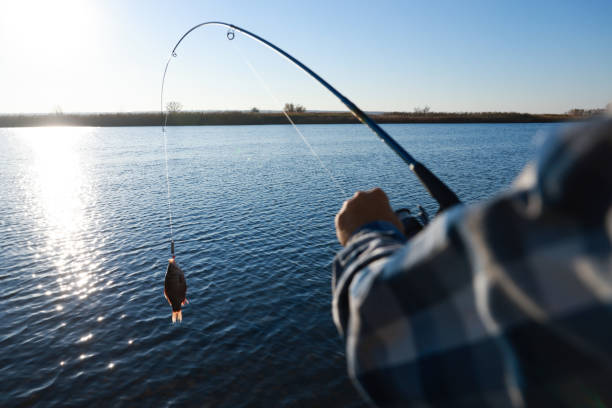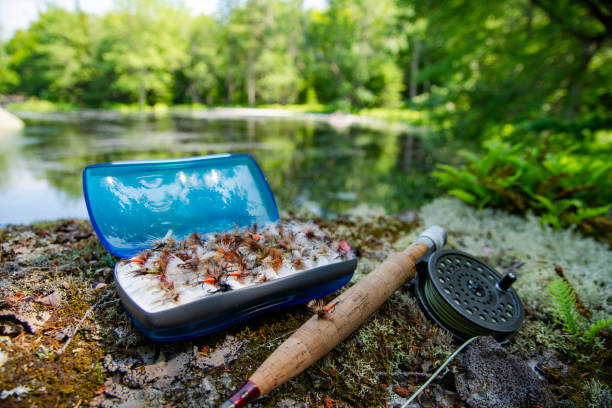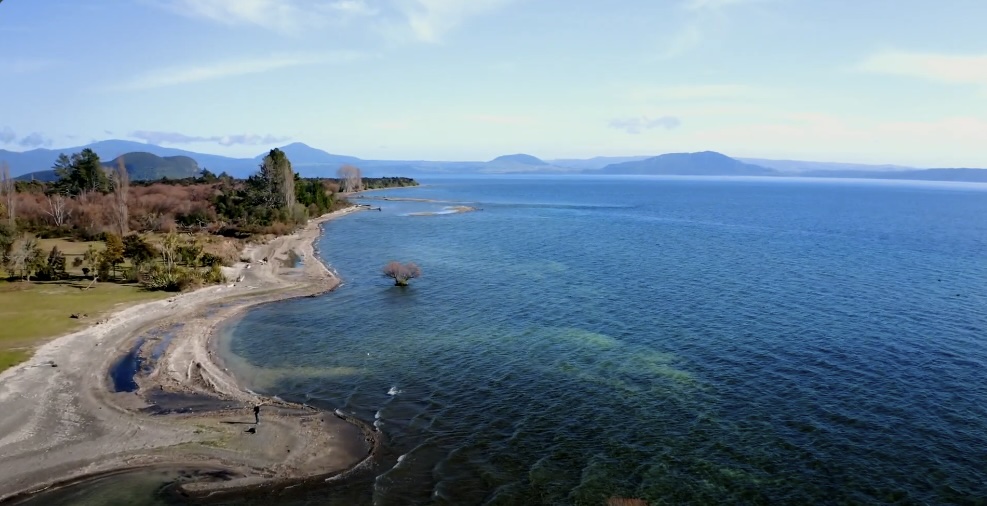Lake Taupo, a crown jewel in the heart of New Zealand’s North Island, offers an exceptional fishing experience, attracting anglers from across the globe. Renowned for its crystal-clear waters and stunning landscapes, Lake Taupo is not just a scenic beauty but also a rich habitat for a variety of fish species. This article delves into the diverse aquatic life of Lake Taupo, focusing specifically on the question: What fish are in Lake Taupo? From fishing tips to the best spots and regulations, we cover all you need to know about fishing in this pristine lake.
The Fish Species of Lake Taupo
Lake Taupo’s aquatic environment is teeming with a variety of fish species, each adding to the rich biodiversity of the area. Here’s a detailed look at the primary fish found in Lake Taupo:
Rainbow Trout
Rainbow trout, introduced to Lake Taupo in the late 19th century, have since become a prominent fixture in its aquatic ecosystem. Flourishing in the cool, deep waters of the lake, rainbow trout are renowned for their vibrant colors and spirited fighting capabilities, making them highly desirable among anglers seeking a thrilling catch.
- Description: Rainbow trout exhibit a striking appearance, with their sleek, torpedo-shaped bodies adorned with vibrant hues ranging from pink to red along their sides. They are further distinguished by a distinctive pink stripe running along their lateral line, adding to their allure.
- Habitat: Preferring cool, oxygen-rich waters, rainbow trout are commonly found in the deeper sections of Lake Taupo, where they can thrive in temperatures conducive to their growth and survival.
- Feeding Habits: Rainbow trout are opportunistic feeders, preying on a variety of aquatic insects, crustaceans, and small fish. They are also known to consume terrestrial insects that fall into the water, making them adaptable and versatile predators.
- Reproduction: In Lake Taupo, rainbow trout typically spawn in the tributary streams during the spring months, where females excavate gravel nests called redds and deposit their eggs. The newly hatched fry then migrate to the lake to grow and mature.
Brown Trout
Brown trout, another non-native species introduced to the waters of New Zealand, have established a thriving population in Lake Taupo. Renowned for their elusive nature and impressive size, brown trout present a challenging yet rewarding pursuit for anglers navigating the depths of the lake.
- Description: Brown trout exhibit a more subdued coloration compared to rainbow trout, with olive-green to brown hues dominating their bodies. They are adorned with scattered black spots along their sides and often display a golden sheen, particularly during the spawning season.
- Behavior: Brown trout are known for their cautious and selective feeding behavior, making them challenging targets for anglers. They often seek refuge in undercut banks, submerged logs, and rocky outcrops, requiring patience and skill to entice them with artificial lures or natural bait.
- Preferred Habitat: Brown trout favor clear, well-oxygenated waters with abundant cover and structure. In Lake Taupo, they can be found in both shallow and deep areas, utilizing the diverse underwater terrain to their advantage.
- Spawning: Like rainbow trout, brown trout in Lake Taupo migrate to tributary streams during the spawning season, where they engage in the intricate courtship rituals before depositing their eggs in redds. The survival of brown trout populations in the lake relies heavily on the availability of suitable spawning habitat and water quality.
Lake Taupo Catfish
Introduced to Lake Taupo in the 1870s, the Lake Taupo catfish has adapted remarkably well to its new environment, establishing itself as a unique component of the lake’s ecosystem. These bottom-dwelling fish, characterized by their whiskered appearance, offer both recreational and culinary opportunities for enthusiasts exploring the depths of the lake.
- Description: Lake Taupo catfish possess a streamlined body with a mottled brown or gray coloration, allowing them to blend seamlessly with their surroundings. They are equipped with prominent barbels around their mouth, which aid in detecting prey and navigating the murky depths.
- Feeding Behavior: As opportunistic scavengers, Lake Taupo catfish feed on a diverse diet that includes aquatic invertebrates, small fish, and organic detritus. Their ability to forage along the lake bottom makes them efficient cleaners, contributing to the overall health of the ecosystem.
- Culinary Value: While Lake Taupo catfish are often overshadowed by other sportfish species, they are prized for their unique culinary appeal. With proper preparation, their firm, white flesh can be transformed into delectable dishes, offering a taste of the lake’s bounty to adventurous epicureans.
- Conservation Challenges: Despite their adaptability, Lake Taupo catfish face conservation challenges stemming from habitat degradation, pollution, and competition with invasive species. Efforts to preserve their populations and maintain the ecological balance of the lake are essential for ensuring their long-term survival.
| Fish Species | Description | Common Size |
| Rainbow Trout | Fast-growing, vibrant fish | 2-10 lbs |
| Brown Trout | Large, elusive, and challenging | 3-15 lbs |
| Lake Taupo Catfish | Bottom-dwelling, whiskered fish | 2-5 lbs |
Best Fishing Spots in Lake Taupo

To experience the best fishing Lake Taupo has to offer, knowing where to cast your line is crucial. Here are some top spots:
Taupo Town
Taupo Town, situated on the northern shore of Lake Taupo, offers diverse fishing opportunities, particularly at the mouth of the Waikato River.
- Target Species: Anglers frequent this area in pursuit of both rainbow and brown trout, attracted by the rich abundance of fish thriving in the cool, deep waters.
- Accessibility: Easily accessible from the town center, the fishing spots near the mouth of the Waikato River cater to anglers of all skill levels, providing convenient access to prime fishing grounds.
- Additional Information: While fishing from the shoreline is popular, hiring a charter boat or kayak allows anglers to explore deeper waters and increase their chances of landing a prized catch.
Turangi
Nestled at the southern end of Lake Taupo, Turangi is renowned as the trout fishing capital of the world, attracting anglers from far and wide seeking unparalleled fishing experiences.
- Trout Haven: Turangi boasts an abundance of trout-rich rivers, streams, and tributaries, offering anglers a diverse range of fishing opportunities throughout the year.
- Accessibility: With easy access to the Tongariro River, Lake Taupo, and numerous fishing lodges and guides, Turangi provides anglers with all the amenities necessary for a successful fishing expedition.
- Fly Fishing Paradise: Fly fishing enthusiasts particularly favor Turangi for its world-class fly fishing opportunities, with the Tongariro River renowned for its challenging yet rewarding trout population.
Western Bays
Located on the western shores of Lake Taupo, the Western Bays offer remote and secluded fishing experiences accessible only by boat.
- Trophy-Sized Trout: These pristine waters are renowned for harboring trophy-sized trout, making them a haven for anglers seeking the ultimate fishing challenge.
- Scenic Beauty: Beyond the thrill of the catch, the Western Bays captivate anglers with their breathtaking scenery, featuring rugged coastlines, native bush, and tranquil bays.
- Boat Access Only: Due to their remote location, accessing the Western Bays typically requires a boat, whether it’s a private vessel, chartered boat, or guided fishing tour.
- Preparation Tips: Anglers venturing into the Western Bays should ensure they have adequate supplies, including fishing gear, safety equipment, and provisions, as amenities may be limited in these remote areas.
Fishing Regulations
Lake Taupo is governed by specific fishing regulations to ensure sustainable fishing practices. Here are some key points:
Licenses
Anglers planning to fish in Lake Taupo must possess a valid fishing license, which can be acquired from local fishing shops or through online channels. It is mandatory to obtain a fishing license before engaging in any fishing activities in the lake.
- Availability: Fishing licenses are readily available for purchase from authorized outlets, ensuring accessibility for anglers of all levels.
- Compliance: Anglers are required to carry their fishing licenses at all times during fishing expeditions and present them upon request by relevant authorities.
Seasons and Limits
Fishing seasons and bag limits in Lake Taupo are subject to regulations that vary based on the species of fish and the specific area within the lake. Staying informed about these regulations is crucial for responsible fishing practices.
- Monitoring: The Department of Conservation regularly updates fishing regulations to reflect changes in fish populations and environmental conditions, ensuring the sustainability of fishing activities.
- Compliance: Anglers are encouraged to check the latest fishing regulations from reliable sources such as the Department of Conservation or local fishing reports to ensure compliance with seasonal restrictions and bag limits.
Fishing Techniques

Understanding these techniques and applying them effectively can significantly enhance the success of your fishing endeavors. Here are some popular fishing techniques used in Lake Taupo:
Fly Fishing
Fly fishing is a highly specialized angling method that is particularly effective for targeting trout in shallower waters. This technique involves the use of lightweight artificial flies made from materials such as feathers, fur, and synthetic materials to imitate natural prey items.
- Description: Fly fishing relies on the use of specialized fly rods, reels, and weighted lines to cast lightweight flies onto the water’s surface with precision and accuracy.
- Advantages: Fly fishing allows anglers to present flies delicately and convincingly to fish, making it ideal for targeting wary trout in clear, shallow streams and rivers.
- Techniques: Anglers can employ a variety of casting techniques, including dry fly fishing, nymph fishing, and streamer fishing, depending on the prevailing conditions and fish behavior.
Trolling
Trolling is a versatile fishing technique that is well-suited for covering large areas of water, especially in deeper areas of the lake where large trout are known to reside. This method involves towing baited lines or lures behind a moving boat at varying speeds.
- Description: Trolling typically requires the use of specialized trolling rods, reels, and downriggers to control lure depth and presentation. Anglers can vary trolling speeds and depths to target different species of fish at various depths within the water column.
- Advantages: Trolling allows anglers to cover expansive areas of water efficiently, increasing the likelihood of encountering actively feeding fish and enticing strikes from large trout.
- Techniques: Anglers can experiment with different trolling speeds, lure colors, and patterns to determine the most effective presentation for enticing fish strikes.
Jigging
Jigging is a versatile fishing technique that is effective for targeting a variety of fish species, including catfish and deep-water trout, in Lake Taupo. This method involves vertically manipulating weighted lures or jigs in the water column to attract fish.
- Description: Jigging requires the use of specialized jigging rods, reels, and heavy jigs or lures designed to sink quickly and imitate natural prey items. Anglers can vary jigging techniques, including vertical jigging, yo-yo jigging, and jigging in place, to entice strikes from fish.
- Advantages: Jigging allows anglers to target fish holding near the lake bottom or suspended in deeper waters, making it an effective technique for catching bottom-dwelling species such as catfish and trout.
- Techniques: Anglers can experiment with jigging rhythms, speeds, and depths to determine the most effective presentation for enticing fish bites.
Conclusion
Lake Taupo not only offers a serene escape into nature but also a thrilling fishing adventure. The variety of fish species in Lake Taupo makes it a premier destination for anglers seeking diversity and challenge. By respecting the local regulations and embracing the best practices recommended by experienced locals, you can enjoy a fruitful and enjoyable fishing experience in New Zealand’s largest lake. Whether you’re a seasoned angler or a curious beginner, Lake Taupo has something to offer everyone looking to answer the question: What fish are in Lake Taupo?
FAQ
The best time for fishing in Lake Taupo varies by species, but generally, the winter months (June to August) are excellent for trout fishing, as the fish are more active.
Yes, there are several spots around Lake Taupo where shore fishing is possible and productive, particularly around stream mouths and shallow bays.
Yes, a variety of guided fishing tours are available, offering both half-day and full-day options with experienced guides to enhance your fishing experience.
Lake Taupo’s fishery is managed with a focus on sustainability. Measures include monitoring fish populations, habitat restoration, and strict regulations on fishing methods and seasons.
